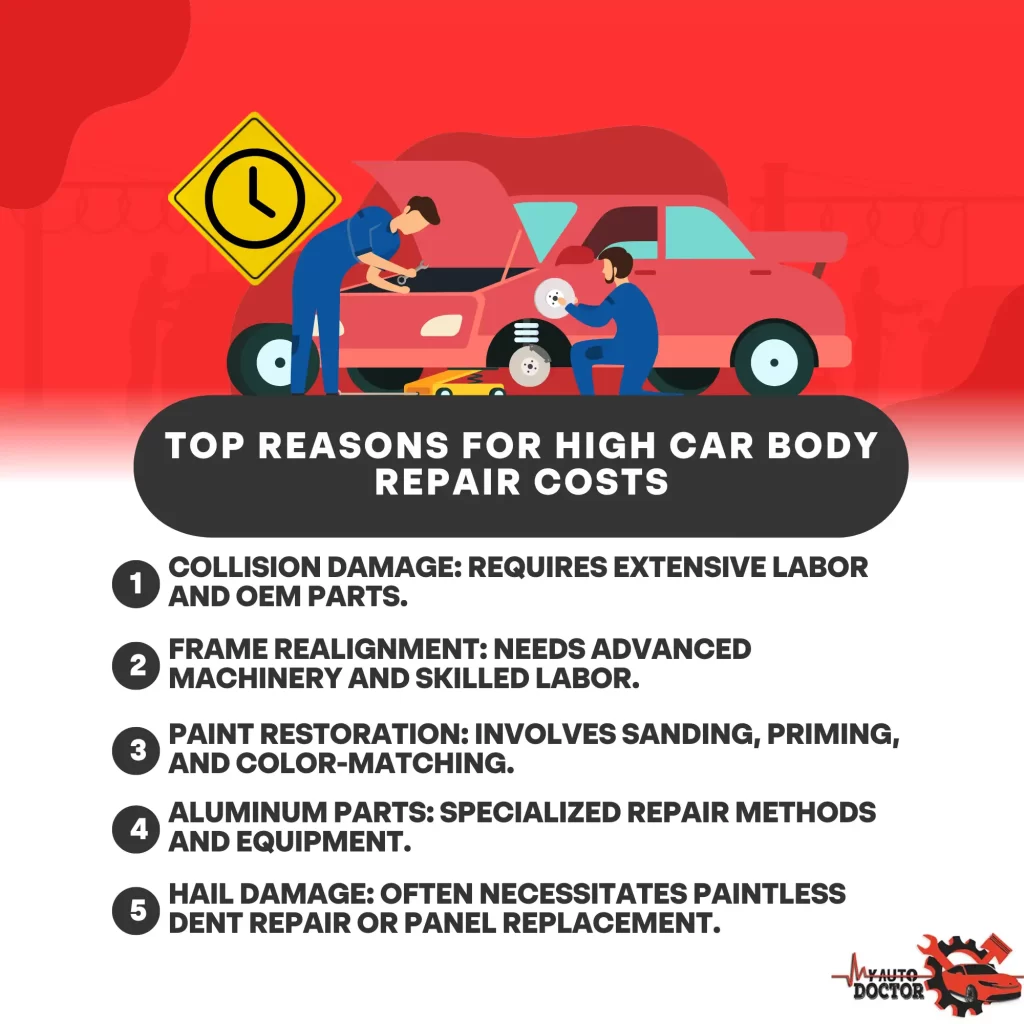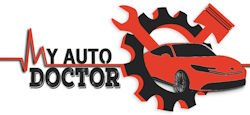You’re likely dealing with costly automobile body repairs from collision damage, necessitating thorough labor and OEM parts. Frame realignment guarantees your vehicle’s chassis is accurately aligned, requiring advanced machinery. Paint restoration includes sanding, priming, and sophisticated color-matching to prevent rust. Aluminum body parts require distinct repair methods and specialized equipment, increasing expenses. Hail damage often necessitates specialized tools for paintless dent repair or complete panel replacement. Each of these repairs not only involves intricate technical work but also high-priced materials. Want to comprehend why these repairs increase your invoice?

Key Takeaways
- Collision damage often requires extensive labor, specialized techniques, and OEM parts for safety and performance.
- Frame realignment demands sophisticated machinery and skilled labor to ensure a safe and stable vehicle foundation.
- Paint restoration involves meticulous sanding, priming, and color matching to protect against rust and ensure a flawless finish.
- Aluminum body parts need specialized repair methods and equipment, resulting in higher labor and material costs than steel parts.
- Hail damage repair may require panel replacement and repainting, especially if the damage is severe and affects the vehicle’s structural integrity.
Collision Damage
Collision damage is often the primary culprit behind expensive car body repairs due to the extensive labor and advanced techniques needed to restore a vehicle’s structural integrity and aesthetic appearance. When your car is involved in an accident, even minor collisions can result in some of the most costly car repairs. The process involves several precise steps, including dent removal, panel replacement, and repainting, which demand specialized skills and equipment.
One of the reasons collision damage leads to such costly car repairs is the need to use OEM (Original Equipment Manufacturer) parts, which guarantee the vehicle meets safety and performance standards. These parts are often more expensive than aftermarket alternatives but are essential for maintaining the car’s integrity. Moreover, modern vehicles come equipped with advanced materials like high-strength steel and aluminum, which require specific repair techniques and tools, further increasing costs.
Additionally, collision damage often affects multiple components, requiring a thorough inspection to identify hidden issues. This could involve damage to internal systems like the suspension, steering, and electrical components, making it one of the priciest repairs on a car. Therefore, addressing collision damage is not just about surface fixes; it demands a detailed and careful approach to safeguard the vehicle’s safety and longevity.
Frame Realignment
Frame realignment, vital for restoring a vehicle’s structural integrity after an accident, involves using specialized equipment to correct any misalignment in the car’s chassis. This process guarantees that the frame is returned to its original specifications, providing a safe and stable foundation for the vehicle. Misalignment can occur from even minor collisions, and if left uncorrected, it can lead to uneven tire wear, poor handling, and further mechanical issues.
When it comes to car repairs, frame realignment is often considered the most expensive thing to fix on a car. The high cost is attributed to the sophisticated machinery and skilled labor required for precise adjustments. Technicians use computerized measuring systems and hydraulic tools to pull the frame back into shape. This meticulous process ensures that the vehicle’s structural integrity is fully restored, which is vital for both safety and performance.
In terms of what is the most expensive car repair, frame realignment ranks near the top due to the complexity and precision required. It’s not just about bending metal back into place; technicians must guarantee that the entire chassis is perfectly aligned. Any errors can compromise the vehicle’s safety, making this a critical and costly repair.
Paint Restoration
Paint restoration, a meticulous process involving sanding, priming, and color matching, is vital for repairing cosmetic damage and maintaining a vehicle’s aesthetic appeal. When your car suffers scratches, oxidation, or fading, the integrity of the paintwork is compromised, leading to potential rust and further deterioration. The process begins with sanding, which removes the damaged or old paint layers to create a smooth surface for refinishing. Using various grits of sandpaper, technicians confirm that the surface is free of imperfections.
Priming follows, involving applying a base layer of primer that facilitates better adhesion of the new paint. Primers also seal the surface, providing a uniform base that prevents rust and corrosion. After priming, the color-matching stage is essential. Technicians use advanced color-matching technology to guarantee the new paint blends seamlessly with the existing color. This involves mixing pigments and testing swatches to achieve an exact match.
Aluminum Body Parts
When dealing with extensive repairs, you’ll often encounter aluminum body parts that require specialized techniques due to their distinctive properties and behavior compared to traditional steel. Aluminum is lighter and more corrosion-resistant but also more prone to work hardening and cracking under stress. This necessitates specific repair methods and tools to guarantee the integrity of the repair.
First, aluminum’s higher thermal conductivity means welding demands precise control over heat input to avoid warping. You’ll need to use dedicated aluminum welding equipment and techniques, such as TIG (Tungsten Inert Gas) welding, to achieve a high-quality bond. Additionally, aluminum’s oxide layer must be removed before welding to prevent contamination.
Second, unlike steel, aluminum can’t be easily reshaped or straightened once damaged; it often necessitates panel replacement rather than repair. This increases both labor and material costs. Specialized adhesives and rivets are also commonly used in aluminum repairs, adding to the complexity and expense.
Hail Damage
Hail damage often results in numerous small dents and dings across a vehicle’s surface, requiring the use of specialized tools and techniques to restore the car’s body to its original state. When hailstones hit, they can cause different levels of damage depending on their size, speed, and the angle of impact. This kind of damage often calls for Paintless Dent Repair (PDR), a cost-effective method that removes dents without the need for sanding, filling, or repainting.
In PDR, technicians utilize specialized tools like dent rods and body picks to carefully massage the metal from behind the panel, pushing the dents outward until the surface is flat. This approach preserves the original paintwork and is often quicker than traditional bodywork. However, severe hail damage might require more extensive repairs, such as panel replacement and repainting, which can be considerably pricier.
Another essential aspect is the vehicle’s material. High-strength steel and aluminum panels react differently to hail impacts and may need different techniques for effective repair. It’s important to consult with a certified professional who has experience with the specific materials and damage types to guarantee ideal outcomes and uphold the vehicle’s structural integrity.
Rust Repair
Rust repair is a vital aspect of maintaining a vehicle’s structural integrity and appearance, often requiring precise techniques like sandblasting, cutting out affected areas, and welding in new metal. When rust forms, it doesn’t just impact the surface but can penetrate deep into the metal. If left unchecked, it can jeopardize the vehicle’s frame and safety.
To address rust effectively, you’ll need to start by identifying the extent of the corrosion. Sandblasting is often used to remove surface rust and reveal the true scope of the damage. Once the affected areas are exposed, cutting out the compromised sections is essential. This guarantees that the rust doesn’t spread to adjacent, healthy metal.
Next, welding new metal patches into the cut-out sections is vital. This process requires precision to guarantee structural integrity and a seamless blend with the existing bodywork. After welding, it’s important to apply rust inhibitors and primers to prevent future corrosion.
Conclusion
When it comes to car body repairs, you’re facing a perfect storm of expenses. From collision damage to frame realignment, and paint restoration to the costly aluminum body parts, each issue is a financial pothole. Don’t forget hail damage and rust repair, which can sneak up like thieves in the night. Understanding these costly culprits equips you with the knowledge to navigate the complex and often pricey landscape of automotive repair, keeping your budget in check.
